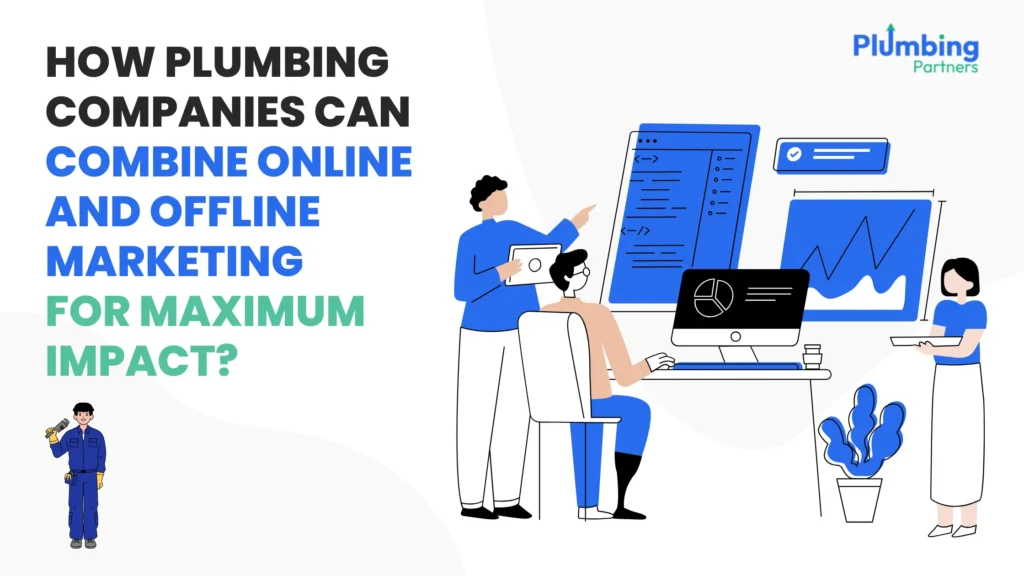Effective online and offline marketing strategies to boost visibility and drive growth for plumbing companies.
In today’s competitive landscape, plumbing companies must harness the power of both online and offline marketing to thrive. While digital marketing offers precision targeting and measurable results, traditional offline methods build trust and community connections.
This article explores how plumbing companies can create a seamless marketing strategy by combining these approaches effectively.
Why Integrating Marketing Strategies is Essential
The keyword here is integration. Plumbing companies often rely on either online or offline marketing, but when combined, these strategies complement each other to create a unified customer journey.
This approach ensures you’re reaching your audience at every touchpoint—from their digital searches to their local community involvement.
The Benefits of a Blended Marketing Strategy
- Increased Reach: By using both channels, you’re tapping into a broader audience.
- Stronger Branding: Consistent messaging across platforms builds brand recognition.
- Better ROI: Leveraging the strengths of each method maximizes your return on investment.
- Enhanced Customer Trust: By showing up in both digital and physical spaces, you create a stronger, more relatable brand presence.
Bridging the Gap Between Digital and Traditional Marketing

Here’s how plumbing companies can align their online and offline efforts for maximum results:
1. Align Messaging Across Channels
A consistent message reinforces your brand. For instance:
- Use the same tagline on your website and print materials.
- Match your social media tone with your radio ads.
Consistency ensures your audience perceives your company as reliable and professional. For example, if your website highlights eco-friendly plumbing solutions, ensure that offline ads, like flyers or event booths, echo the same green messaging.
Quick Win: Keep your branding consistent. Check out our guide on social media marketing for actionable tips.
2. Use Digital to Amplify Offline Efforts
Digital tools can supercharge your offline campaigns:
- Promote local sponsorships on social media.
- Send email newsletters about upcoming community events.
- Use geotargeted ads to invite nearby customers to your physical store or special events.
When you highlight offline efforts online, it creates a loop of engagement, drawing customers from one channel to another. For instance, live-streaming a sponsored community event can expand your reach beyond the attendees.
Next: Discover how email marketing can bridge the gap in our detailed guide.
3. Leverage Local SEO for Foot Traffic
Optimize your Google My Business profile to attract local customers searching online, then drive them to your physical location or events. Here’s how:
- Add your address, phone number, and operating hours.
- Encourage satisfied customers to leave reviews.
- Use photos and videos to showcase your services and team.
Local SEO doesn’t just help you appear in search results—it helps you stand out. Businesses with numerous positive reviews are more likely to attract clicks and visits.
Pro Tip: Learn how to dominate your local area in our step-by-step local SEO blog.
4. Combine Offline Advertising with Digital Call-to-Actions
Add QR codes to your flyers or billboards that link to your website or appointment scheduler. This approach seamlessly connects offline ads with digital actions.
Example:
- A flyer for a seasonal plumbing inspection could include a QR code directing users to an online booking page.
- At trade shows, distribute business cards with links to download a free plumbing maintenance checklist.
This hybrid approach not only saves time for your customers but also allows you to track engagement and conversions.
5. Track and Analyze Results
Use tracking tools to measure the impact of your integrated strategy. For example:
- Assign unique promo codes for offline ads to track conversions.
- Use Google Analytics to monitor website traffic from offline campaigns.
Tracking results ensures you’re making data-driven decisions. When you understand what works best, you can allocate your resources more effectively.
Quick Win: Not sure where to start? Learn how a marketing agency can help with analytics in our marketing agency blog.
Practical Steps to Implement Integrated Marketing

A Step-by-Step Guide:
- Audit Your Current Strategies:
- List all your current online and offline efforts.
- Identify gaps or overlaps in messaging and targeting.
- Set Clear Goals:
- Define what you want to achieve with integration (e.g., increased leads, better brand recognition).
- Develop a Unified Plan:
- Map out how each channel will complement the other.
- For instance, if you’re launching a direct mail campaign, plan an email follow-up.
- Train Your Team:
- Ensure all team members understand the importance of a unified approach.
- Monitor Progress:
- Use analytics tools and customer feedback to refine your strategy.
Pro Tip: Build trust with consistent content. Explore how content marketing can support your goals in our trust-building blog.
Success Stories: Integrated Marketing in Action
Case Study 1: Local Plumbing Business Boosts Visibility
A small plumbing company combined local event sponsorship with a robust social media campaign. By promoting their participation online and engaging with attendees offline, they increased client inquiries by 35% in three months.
Key Takeaways:
- Use social media to amplify local presence.
- Consistent branding enhances trust and recognition.
Case Study 2: Seasonal Discounts Across Channels
Another company advertised a winter drain-cleaning discount via direct mail and digital ads. They used promo codes unique to each channel, discovering that 40% of conversions came from offline efforts, while digital ads drove another 60%.
Key Takeaways:
- Offline methods still drive substantial results.
- Combining channels provides better insights into customer behavior.
Final Thoughts
Integrating online and offline marketing strategies can propel your plumbing business to new heights. By leveraging the strengths of both, you can create a cohesive approach that attracts customers, builds trust, and drives results.
Ready to Elevate Your Marketing?
Explore our ultimate marketing strategies guide for plumbing companies or visit plumbingpartners.co for personalized solutions tailored to your business.





